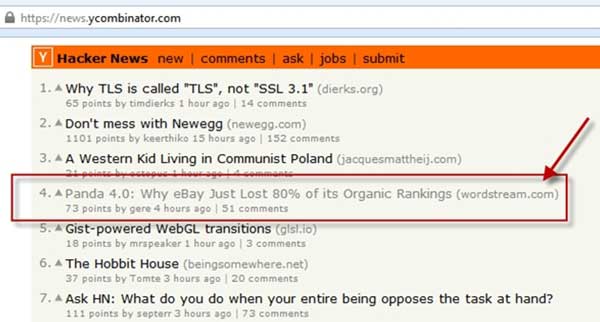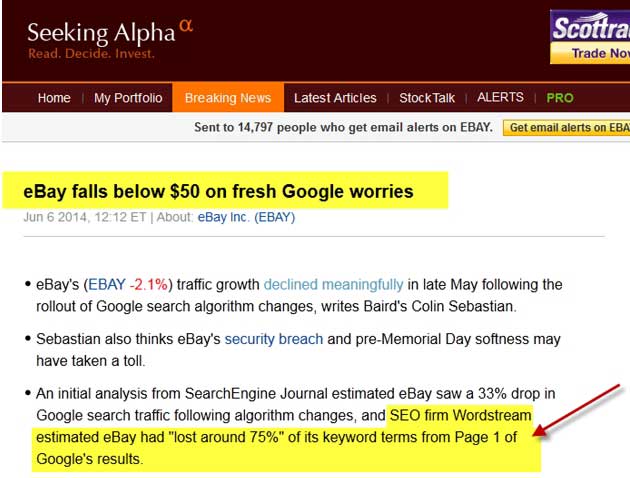Content marketing can be a great way to gain exposure for your company, but getting the media to care about your brand's news is difficult. Unless you're a Fortune 500 company, mainstream media, and even industry publications, probably won't cover your news.
You can try newsjacking—inserting your ideas and commentary into breaking news in the hopes of being quoted. Journalists get a ton of such press releases, though, and yours is usually just another needle in the haystack.
So how can you use content marketing to break into popular news stories?
We recently got in on a story that generated a massive amount of exposure and valuable citations for my company, WordStream. Our blog post on the effect that Google's Panda 4.0 algorithm had on eBay's organic search rankings ended up earning...
- Over 400 views a minute on our website at the height of its popularity
- Front page, top-spot placement on Hacker News (see image below) and an Editor's Pick mention on ArsTechnica

- Over 50,000 views within a couple of days of the story breaking, and over a quarter of a million across sites in total, to date
- Citations and valuable links from over 50 publications, including the Guardian, Ecommerce Bytes, MediaPost, and Business Insider.
When news media talked about why eBay's stock price plunged, they cited our branded research:

You may not have the resources to do this on a weekly or monthly basis, but every company could have at least a few content marketing wins a year using the following tips. Imagine what that could do for your Web presence and reputation!
1. Seek out content opportunities
Pick stories that matter to you, and follow them closely.
We had been keeping an eye on eBay's online marketing tactics for over a year, ever since it published a highly critical report on AdWords. It was plain to see that in addition to its paid search troubles, its organic strategy—with thin content and millions of spammy pages—was going to get the company in trouble.
These industry stories can become opportunities for you to generate awesome content, if you keep your eyes open.
Takeaway: Use Google Alerts for news and subscribe to the company blogs of brands you're interested in. Stay current and news and be prepared to take action quickly.
2. Know your value offering
What makes your take on the story any different from the next guy's?
As soon as we heard about the eBay story, we started running our own research so we could offer original data to publications interested in covering the news.
Come up with something unique and tangible that no one else has, and you'll win the interest of journalists.
Takeaway: Come up with three or four angles for your story, and then ask people in your journalist network: What kind of information are you looking for? What would be most valuable to you as you cover this issue?
3. Answer this: 'So what?'
So this thing is happening, whatever it may be... so what?
If you want journalists to take an interest in your branded content, you need to tell them why it matters to their readers.

We figured out the "so what" factor for investors, eBay sellers, marketers, and the general public, and then pitched to different publications based on what mattered to their audience.
Takeaway: Don't leave people wondering what the point is—or, worse, leave them thinking you just had to get your two cents in but didn't say anything worthy. Your take on the story has to pass the "so what" test.
4. Plan to promote
Awesome content just ends up buried in the bowels of the Web if it's not promoted.
Figure out how you're going to promote your content before you even begin creating it. Will you have shareable images? Will video add to the story? What format is going to appeal to the people you're trying to reach?
Takeaway: Make promotion a part of your content creation process from start to finish.
5. Go beyond social
If your content promotion strategy consists only of loading up HootSuite and blasting it out to your networks, you're selling yourself (and your content) short.
Join relevant groups on each network and share there (without spamming). Try the LinkedIn publishing tool, which earned us another 10,000 views and 40 comments.
Also reach out to influential industry bloggers and social personalities; you can find many of them by using tools like Followerwonk or BuzzSumo (pictured above). Paid promotion or native ad placements might be an option, depending on your budget.
Takeaway: Check out different channels, groups, and tools for content promotion. Actively do targeted outreach and learn where online you can find the people you want to get your content in front of.
6. Build a solid network of media contacts
Journalists will get really sick of you (really fast) if the only time they ever hear from you is when you're promoting your stuff.
It takes time and energy to build a media contacts network, but it's so worth it. Learn who covers which types of stories or topics, and then share interesting, relevant information with them as they come up—and not your own all the time, either.
When you do contact them with your own unique, original story, they'll know you as the person who shares only quality stuff with them.
Takeaway: Nurture a network of media contacts and be genuine. Get your foot in the door long before your story comes along so that you have a receptive audience for your pitches.
7. Be part of the conversation
Use a tool such as Topsy to find the social conversations happening around your content and get in the game. Respond to comments on the various publications that have cited your work. Answer questions. Thank people for sharing.
Takeaway: Become involved and stay involved in the buzz around your content. Seek out opportunities to be part of the conversation.
Buzz begets buzz
Content rarely becomes super popular by accident. Develop a content creation and promotion process that works for you, using the resources at your disposal. With each new campaign, you'll have learned valuable lessons about which channels and tactics work best for you.
The payoff can be massive—citations from major newspapers, appearances as an expert on a TV show, valuable backlinks, and huge cred in your industry.






